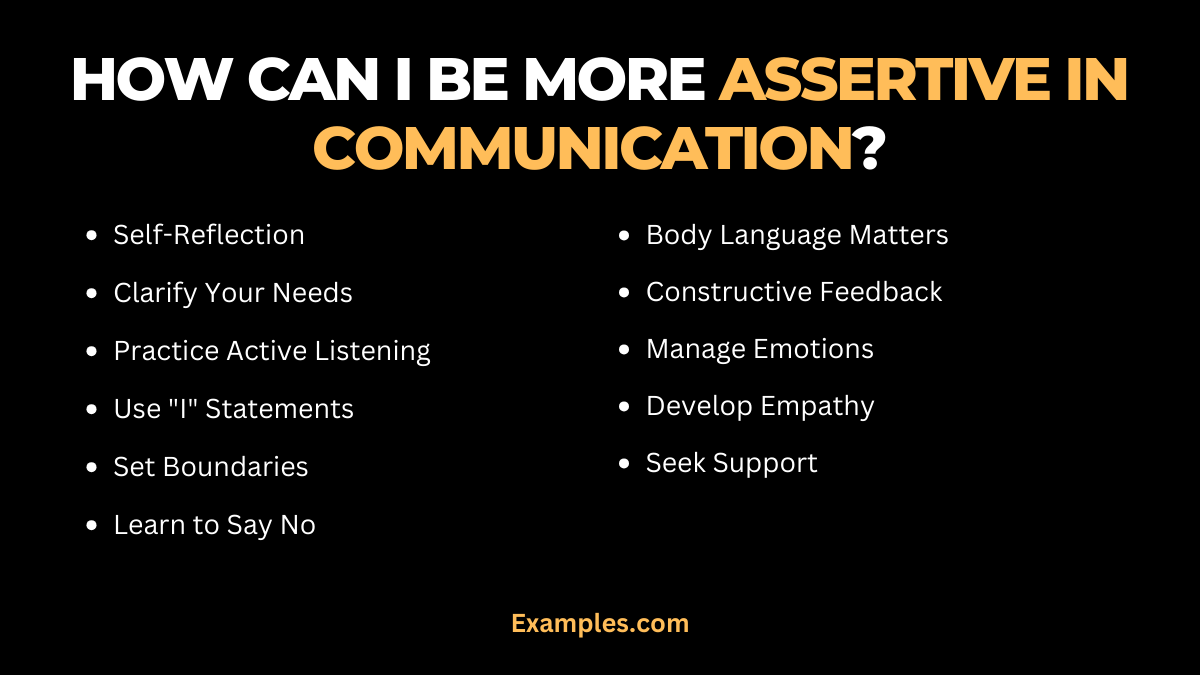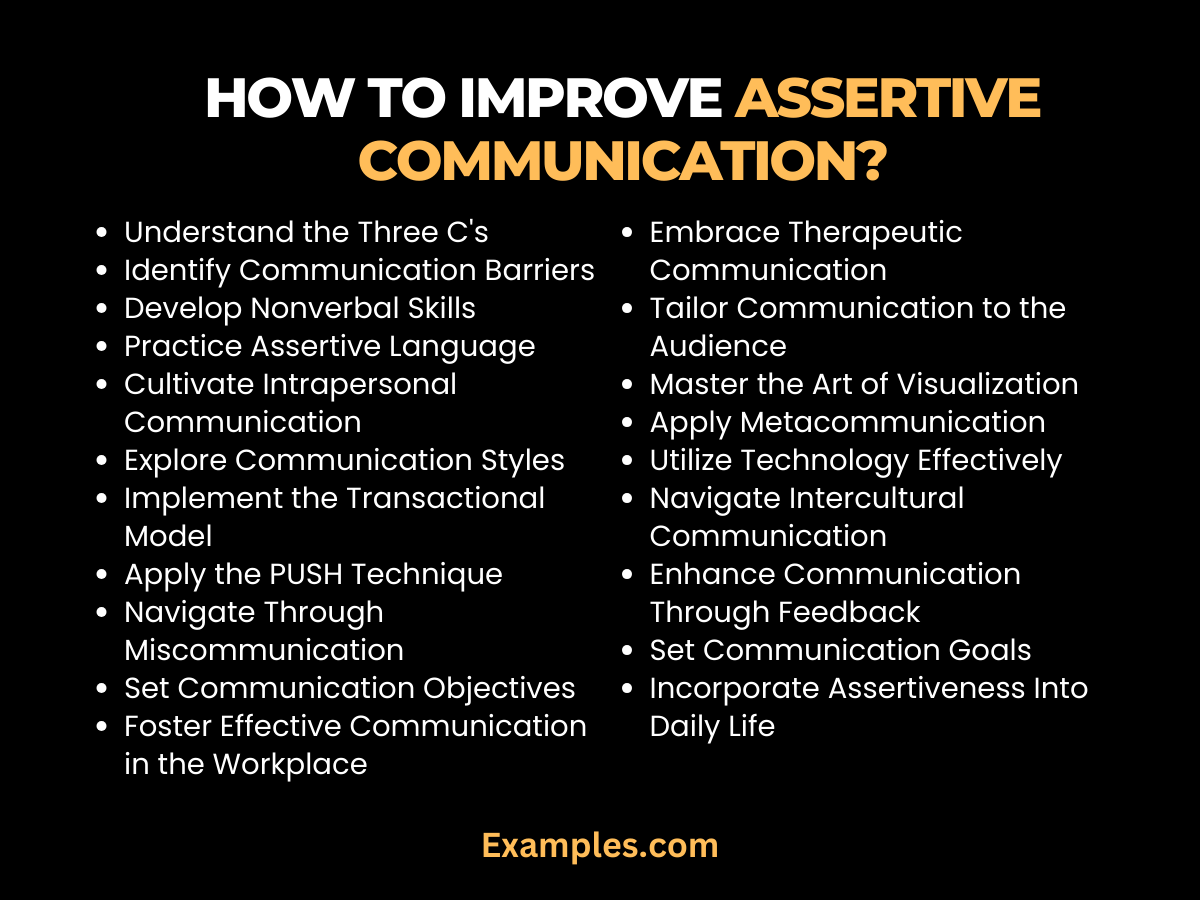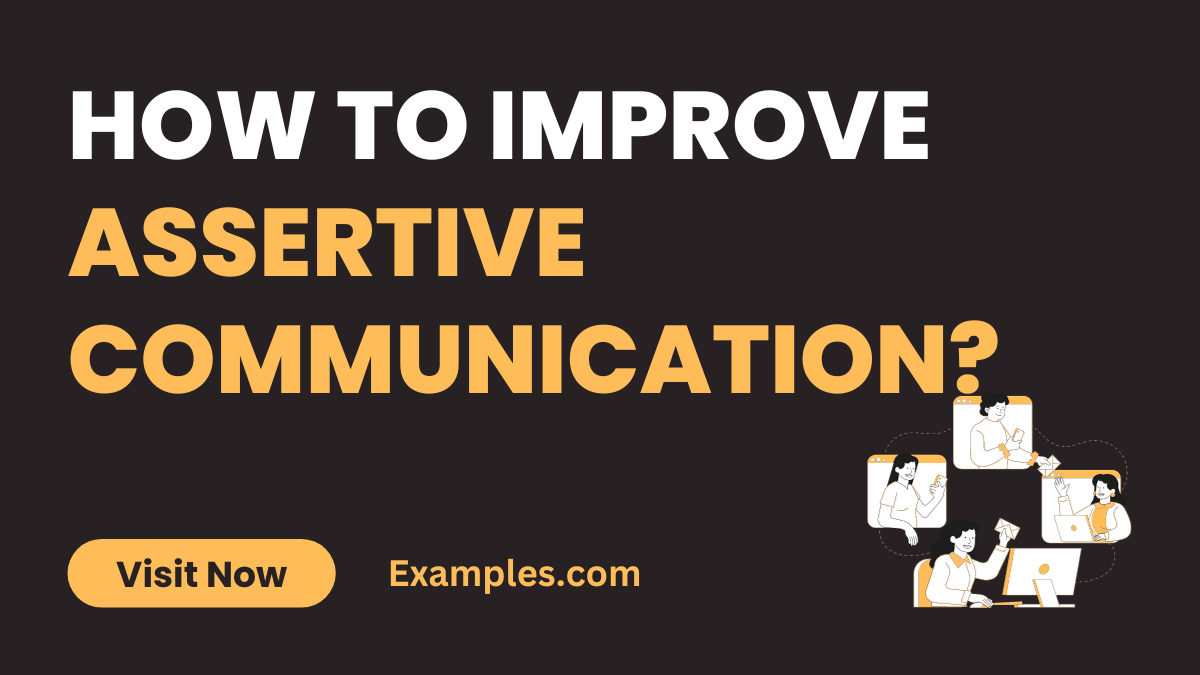How to Improve Assertive communication – 19+ Examples, How to Improve
Unlock the art of assertive communication with our comprehensive guide, designed to empower your interpersonal skills. Discover the three essential C’s of assertiveness, grasp effective communication strategies, and learn through real-world Communication Examples. This complete resource provides actionable tips to enhance your verbal and nonverbal communication, ensuring you navigate any scenario with confidence. Elevate your assertiveness, break communication barriers, and cultivate a powerful, authentic voice in both personal and professional spheres. Explore the transformative journey to improved assertive communication now!
How Can I Be More Assertive in Communication?
In the realm of effective communication, assertiveness plays a pivotal role. If you find yourself wanting to enhance your assertive communication skills, follow these actionable steps

- Self-Reflection: Begin by understanding your communication style. Reflect on past interactions and identify areas for improvement.
- Clarify Your Needs: Clearly articulate your thoughts, feelings, and needs. Be specific about what you want to convey to ensure a precise message.
- Practice Active Listening: Cultivate the habit of listening attentively. Acknowledge others’ perspectives before expressing your own, fostering open communication.
- Use “I” Statements: Frame your thoughts with “I” statements to express feelings and opinions without sounding accusatory. For example, say, “I feel” instead of “You always.”
- Set Boundaries: Establish personal boundaries to protect your time and energy. Clearly communicate limits, allowing others to respect your space.
- Learn to Say No: Assertiveness involves setting priorities. Don’t hesitate to decline requests or commitments when necessary. A polite but firm “no” is an essential skill.
- Body Language Matters: Pay attention to nonverbal cues. Maintain eye contact, stand tall, and use gestures to emphasize your points. Confident body language reinforces assertiveness.
- Constructive Feedback: Provide and receive feedback constructively. Focus on specific behaviours and their impact, fostering a growth-oriented conversation.
- Manage Emotions: Assertiveness doesn’t mean suppressing emotions. Learn to express feelings calmly and assertively without becoming aggressive or passive.
- Develop Empathy: Understand others’ perspectives and acknowledge their feelings. Empathy fosters a collaborative environment and strengthens relationships.
- Seek Support: Surround yourself with individuals who encourage assertiveness. Share your goals with trusted friends or mentors who can provide guidance and feedback.
How to Improve Assertive Communication
Improving assertive communication involves a multifaceted approach. Follow these comprehensive steps to foster assertiveness in your interactions

- Understand the Three C’s: Learn and implement the three fundamental aspects of assertive communication – Clarity, Confidence, and Control.
- Identify Communication Barriers: Recognize common obstacles to assertiveness, such as fear of conflict or rejection. Addressing these barriers is crucial for improvement.
- Develop Nonverbal Skills: Master nonverbal cues like eye contact, posture, and gestures. Effective nonverbal communication enhances the impact of your assertive messages.
- Practice Assertive Language: Choose words that convey your thoughts assertively. Avoid passive or aggressive language to maintain a balanced communication style.
- Cultivate Intrapersonal Communication: Understand your thoughts and emotions. Intrapersonal communication awareness forms the foundation of assertiveness.
- Explore Communication Styles: Familiarize yourself with different communication styles, recognizing the strengths and weaknesses of each. Tailor your approach for optimal effectiveness.
- Implement the Transactional Model: Grasp the transactional model of communication, understanding that messages are interactive and influenced by feedback.
- Apply the PUSH Technique: Use the PUSH (Persist Until Something Happens) technique to navigate through challenging conversations and achieve assertive outcomes.
- Navigate Through Miscommunication: Develop strategies to address and rectify misunderstandings promptly. Effective communication involves addressing miscommunication with clarity.
- Set Communication Objectives: Define clear objectives for each communication. Knowing what you want to achieve ensures purposeful and assertive interactions.
- Foster Effective Communication in the Workplace: Apply assertive communication techniques to workplace scenarios. Establishing clear communication norms enhances team dynamics.
- Embrace Therapeutic Communication: Utilize therapeutic communication techniques to build trust and rapport, especially in sensitive or emotional situations.
- Tailor Communication to the Audience: Adjust your communication style based on the audience. Tailoring your approach enhances receptivity and understanding.
- Master the Art of Visualization: Use visualization techniques to mentally prepare for assertive communication scenarios. Visualization enhances readiness and confidence.
- Apply Metacommunication: Develop metacommunication skills to navigate complex conversations. Addressing the communication process itself reinforces assertiveness.
- Utilize Technology Effectively: Leverage communication technology to enhance assertiveness. Choose appropriate channels and tools for clear and efficient interactions.
- Navigate Intercultural Communication: Recognize and appreciate cultural differences in communication. Adapting your style fosters effective cross-cultural interactions.
- Enhance Communication Through Feedback: Seek and provide constructive feedback. Feedback loops are essential for continual improvement in assertive communication.
- Set Communication Goals: Establish short and long-term communication goals. Goals provide direction and motivation for ongoing assertiveness development.
- Incorporate Assertiveness Into Daily Life: Integrate assertive communication into your daily interactions. Consistent practice solidifies assertiveness as a natural part of your communication repertoire.
11 Ways to Become More Assertive
Enhancing assertive communication involves adopting specific strategies. Here are eleven actionable ways to cultivate assertiveness in your interactions:
- Define Your Communication Goals: Clearly outline your objectives for each interaction, ensuring a purposeful and assertive conversation.
- Utilize Positive Affirmations: Boost your self-esteem with positive affirmations. Remind yourself of your strengths to instil confidence in your communication.
- Role Play Scenarios: Practice assertive communication in various scenarios. Role-playing allows you to refine your skills in a risk-free environment.
- Join Assertiveness Training: Consider participating in assertiveness training programs or workshops. These sessions provide practical techniques and guidance.
- Visualize Success: Picture successful assertive interactions in your mind. Visualization can enhance your confidence and readiness for real-life situations.
- Celebrate Small Wins: Acknowledge and celebrate your progress. Recognizing small victories builds confidence and reinforces assertive behaviour.
- Learn from Role Models: Identify assertive communicators in your life or through media. Observe their techniques and incorporate them into your own style.
- Embrace Discomfort: Assertiveness might initially feel uncomfortable. Embrace discomfort as a sign of growth and persevere through challenging conversations.
- Continuous Self-Reflection: Regularly assess your communication style. Identify areas of improvement and adjust your approach based on feedback and self-reflection.
- Take Initiative: Be proactive in expressing your thoughts and needs. Waiting for the perfect moment may lead to missed opportunities for assertive communication.
- Stay Consistent: Cultivate consistency in your assertiveness. Practice it across various situations to make it a natural part of your communication style.
In concluding the guide on How to Improve Assertive Communication, it’s clear that the development of assertive communication skills is a transformative journey, vital for both personal and professional growth. As the University of California, Davis (UC Davis) highlights, assertiveness is key in expressing feelings, opinions, and needs openly and honestly, without violating others’ rights. This skill is particularly important for college students as they navigate relationships, career paths, and various social interactions, helping in developing communication skills, boosting self-confidence, and increasing self-esteem??.
Furthermore, the Mayo Clinic emphasizes the importance of assertive communication in managing stress and improving overall coping skills. Assertive communication is not just about what you say, but how you say it – it’s a direct and respectful way of expressing oneself that ensures your message is clearly delivered. This communication style, based on mutual respect, allows you to stand up for your interests and express your thoughts and feelings effectively, while also being mindful of others’ rights. It’s a powerful tool in conflict resolution and in establishing honest, healthy relationships??.
For more insights on developing assertiveness and its impact on communication skills, UC Davis provides valuable information on their Assertiveness page. Additionally, the Mayo Clinic offers a comprehensive view on the role of assertiveness in reducing stress and improving communication on their page, “Being assertive: Reduce stress, communicate better”. These resources can be immensely helpful for anyone looking to enhance their assertive communication skills and understand its significance in personal and professional settings.



